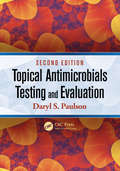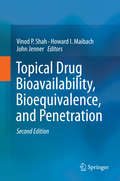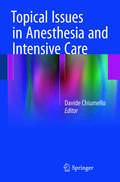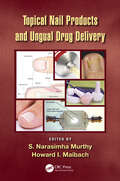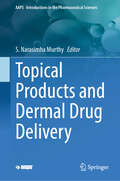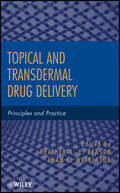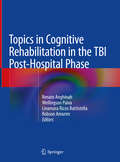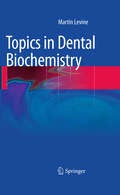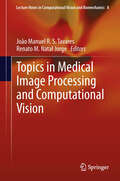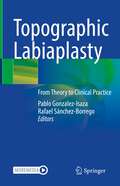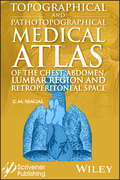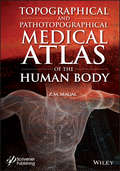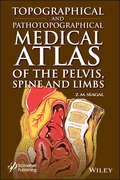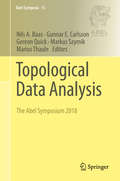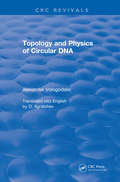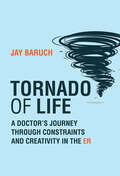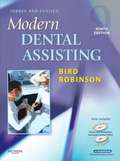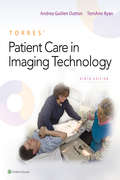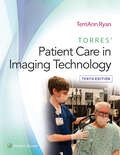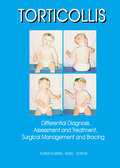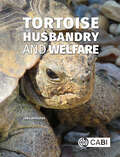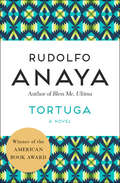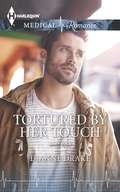- Table View
- List View
Topical Antimicrobials Testing and Evaluation
by Daryl S. PaulsonA range of factors must be considered when developing a topical antimicrobial for use in a healthcare personnel handwash, surgical scrub, or preoperative skin preparation. Antimicrobial effectiveness, low skin irritation, ease of use, and pleasing aesthetics are all essential if the product is to succeed. In addition, all facets of the product must
Topical Drug Bioavailability, Bioequivalence, and Penetration
by Howard I. Maibach Vinod P. Shah John JennerThis authoritative volume explores advances in the techniques used to measure percutaneous penetration of drugs and chemicals to assess bioavailability and bioequivalence and discusses how they have been used in clinical and scientific investigations. Seven comprehensive sections examine topics including in vitro drug release, topical drugs products, clinical studies, and guidelines and workshop reports, among others. The book also describes how targeted transdermal drug delivery and more sophisticated mathematical modelling can aid in understanding the bioavailability of transdermal drugs. The first edition of this book was an important reference guide for researchers working to define the effectiveness and safety of drugs and chemicals that penetrated the skin. This second edition contains cutting-edge advances in the field and is a key resource to those seeking to define the bioavailability and bioequivalence of percutaneously active compounds to improve scientific and clinical investigation and regulation.
Topical Issues in Anesthesia and Intensive Care
by Davide ChiumelloThis book describes the state of the art concerning some of the most hotly debated topics in anesthesia and intensive care and is at the same time intended to serve as a useful practical guide that will assist in improving outcomes. The topics covered are wide ranging and include, for example, the use of antibiotics during renal replacement therapy, the role of video laryngoscopy, management of mechanical ventilation in the operating room, use of high-frequency ventilation in patients with respiratory failure, management of the potentially brain dead patient, perioperative delirium, cardiac protection during general anesthesia, single-lung ventilation, and use of lung imaging in critically ill patients. Written by recognized experts in the field, the book will offer a comprehensive and easy to understand update for specialists and students of anesthesia and intensive care.
Topical Nail Products and Ungual Drug Delivery
by Howard I. Maibach S. Narasimha MurthyDiscussing existing techniques, ongoing research, new approaches, and basic concepts in the treatment of nail diseases, Topical Nail Products and Ungual Drug Delivery summarizes the current knowledge and represents a jumping-off point for creating novel techniques of drug delivery across the nail.A growing area of pharmaceutical research, the searc
Topical Products and Dermal Drug Delivery (AAPS Introductions in the Pharmaceutical Sciences #2)
by S. Narasimha MurthyThe book Topical Products and Dermal Drug Delivery delves deeply into critical topics essential for professionals across industry, academia, and clinical research. Inspired by a decade of groundbreaking global research, much of which has received USFDA funding, this comprehensive work offers readers valuable insights with a regulatory lens woven into many chapters. Notably, the book provides a pioneering depth of coverage on certain subjects. A unique perspective has been provided by the authors regarding topics such as metamorphosis, in vitro permeation testing, sublimation of APIs, quality attributes of topical products, microscopic techniques and MuST studies.
Topical and Transdermal Drug Delivery
by Adam C. Watkinson Heather A. BensonPractical drug development approaches presented by leading expertsDesigned to support the development of new, effective therapeutics, Topical and Transdermal Drug Delivery: Principles and Practice explains the principles underlying the field and then demonstrates how these principles are put into practice in the design and development of new drug products. Drawing together and reviewing the latest research findings, the book focuses on practical, tested, and proven approaches that are backed by industry case studies and the authors' firsthand experience. Moreover, the book emphasizes the mechanistic information that is essential for successful drug product development.Topical and Transdermal Drug Delivery: Principles and Practice is divided into two parts:Part One, Current Science, Skin Permeation, and Enhancement Approaches, offers readers a fundamental understanding of the underlying science in the field. It describes the principles and techniques needed to successfully perform experimental approaches, covering such issues as skin permeation, enhancement, and assessment.Part Two, Topical and Transdermal Product Development, guides readers through the complete product development process from concept to approval, offering practical tips and cautions from experts in the field. This part also discusses regulations that are specific to the development of dermal drug products. The final chapter explores current and future trends, forecasting new development techniques and therapeutics.Throughout the book, the authors clearly set forth the basic science and experimental procedures, making it possible for researchers to design their own experimental approaches and accurately interpret their results.With contributions from experienced drug researchers, this text is highly recommended for all researchers involved in topical and transdermal product development who need to know both the state of the science and the standards of practice.
Topics in Cognitive Rehabilitation in the TBI Post-Hospital Phase
by Renato Anghinah Wellingson Paiva Linamara Rizzo Battistella Robson AmorimTraumatic brain injury (TBI) refers to nondegenerative, noncongenital damage to the brain from an external mechanical force, which can lead to permanent or temporary impairment of cognitive, physical, and psychosocial functions, with an associated diminished or altered state of consciousness. Despite this broad definition, it is estimated that more than 1.500.000 people suffer TBI annually in US, with 20% afflicted with moderate or severe forms. Additionally, a high percentage of these patients are unable to return to their daily routine (approximately 50%). In this context, both motor and cognitive rehabilitation are extremely important for these individuals. The aim of cognitive and motor rehabilitation is to recover an individual’s ability to process, interpret and respond to environmental inputs, as well as to create strategies and procedures to compensate for lost functions that are necessary in familial, social, educational and occupational settings. The purpose of this book is to review the basic concepts related to TBI, including mechanisms of injury, acute and post-acute care, severity levels, the most common findings in mild, moderate and severe TBI survivors, and the most frequent cognitive and motor impairments following TBI, as well as to discuss the strategies used to support post-TBI patients. The most important rehabilitation techniques, both from cognitive and motor perspectives, are addressed. Finally, information regarding work and community re-entry and familial and psychological support are discussed in detail.Topics in Cognitive Rehabilitation in the TBI Post-Hospital Phase is intended as a reference guide for all professionals who have contact with or are related to patients suffering from TBI. Any professionals who work with or are related to patients suffering from TBI will find here a broad and comprehensive overview of TBI, addressing all essential issues, from acute care to rehabilitation strategies, follow up and re-socialization.
Topics in Dental Biochemistry
by Martin LevineOver the last 20 years, biochemistry and molecular biology have undergone a revolution that has affected our understanding of the oral cavity. Topics in Dental Biochemistry is primarily designed for students of dentistry who need to relate biochemistry and molecular biology to dentally related topics in physiology, nutrition, anatomy, histology, microbiology, and immunology. The book will also be of value for dental professionals, scientists, and practitioners of medicine who are interested in hard and soft tissue structure and disease. It provides the necessary basic scientific background for a clearer understanding of bone, tooth, saliva, and surrounding soft tissue research and also for an appreciation of how dental caries and periodontal disease might be better diagnosed and controlled in the future. Dentistry was developed to treat dental caries, but since the early 20th century it has increasingly been treating periodontal, traumatic and genetic diseases affecting tooth structure and attachment. Fluoridation is discussed at length. Other methods for controlling dental caries and new or suggested methods for controlling oral hygiene and periodontal disease are also discussed.
Topics in Medical Image Processing and Computational Vision
by Renato M. Natal Jorge Joao Manuel TavaresThe sixteen chapters included in this book were written by invited experts of international recognition and address important issues in Medical Image Processing and Computational Vision, including: Object Recognition, Object Detection, Object Tracking, Pose Estimation, Facial Expression Recognition, Image Retrieval, Data Mining, Automatic Video Understanding and Management, Edges Detection, Image Segmentation, Modelling and Simulation, Medical thermography, Database Systems, Synthetic Aperture Radar and Satellite Imagery. Different applications are addressed and described throughout the book, comprising: Object Recognition and Tracking, Facial Expression Recognition, Image Database, Plant Disease Classification, Video Understanding and Management, Image Processing, Image Segmentation, Bio-structure Modelling and Simulation, Medical Imaging, Image Classification, Medical Diagnosis, Urban Areas Classification, Land Map Generation. The book brings together the current state-of-the-art in the various multi-disciplinary solutions for Medical Image Processing and Computational Vision, including research, techniques, applications and new trends contributing to the development of the related areas.
Topographic Labiaplasty: From Theory to Clinical Practice
by Pablo Gonzalez-Isaza Rafael Sánchez-BorregoThis book provides the reader a fully descriptive approach of labia minora hypertrophy and clitoral hood elongation related to anatomical variants. The expert contributors present their reproducible and structured technique of Topographic Labiaplasty, that allows the surgeon to improve surgical results and avoid complications and poor aesthetic outcomes. It also enables surgeons to understand the huge anatomical variants related to labia minora hypertrophy and clitoral frenulum complex aiming a better result from the aesthetic and functional point of view.The eighteen well written chapters include a brief historical research about the history of labiaplasty, classifications of labia minora hypertrophy, indications and contraindications for the surgery, anesthetic considerations, surgical instrumentation, reconstructive aspects, labiaplasty in teenagers and the sexological impact. The book also features surgical videos.Topographic Labiaplasty - From Theory to Practice is addressed to consultants in gynecology, plastic surgery, urogynecology and those interested in female cosmetic genital surgery.
Topographical and Pathotopographical Medical Atlas of the Chest, Abdomen, Lumbar Region, and Retroperitoneal Space
by Z. M. SeagalWritten by an experienced and well-respected physician and professor, this new volume, building on the previous volume, Ultrasonic Topographical and Pathotopographical Anatomy, and its sequel, Topographical and Pathotopographical Medical Atlas of the Head and Neck, also available from Wiley-Scrivener, presents the ultrasonic topographical and pathotopographical anatomy of the chest, abdomen, lumbar region, and retroperitoneal space, offering further detail into these important areas for use by medical professionals. This series of atlases of topographic and pathotopographic human anatomy is a fundamental and practically important book designed for doctors of all specializations and students of medical schools. Here you can find almost everything that is connected with the topographic and pathotopographic human anatomy, including original graphs of logical structures of topographic anatomy and development of congenital abnormalities, topography of different areas in layers, pathotopography, computer and magnetic resonance imaging (MRI) of topographic and pathotopographic anatomy. Also you can find here new theoretical and practical sections of topographic anatomy developed by the author himself which are published for the first time. They are practically important for mastering the technique of operative interventions and denying possibility of iatrogenic complications during operations. This important new volume will be valuable to physicians, junior physicians, medical residents, lecturers in medicine, and medical students alike, either as a textbook or as a reference. It is a must-have for any physician’s library.
Topographical and Pathotopographical Medical Atlas of the Human Body
by Z. M. SeagalWritten by an experienced and well-respected physician and professor, this new volume combines the entire previous four books, Ultrasonic Topographical and Pathotopographical Anatomy, and its three sequels, also available from Wiley-Scrivener, presenings the ultrasonic topographical and pathotopographical anatomy of the entire body, offering further detail into these important areas for use by medical professionals. This comprehensive and exhaustive medical atlas of topographic and pathotopographic human anatomy is a fundamental and practically important book designed for doctors of all specializations and students of medical schools. Here you can find almost everything that is connected with the topographic and pathotopographic human anatomy, including original graphs of logical structures of topographic anatomy and development of congenital abnormalities, topography of different areas in layers, pathotopography, computer and magnetic resonance imaging (MRI) of topographic and pathotopographic anatomy. You can also find here new theoretical and practical sections of topographic anatomy developed by the author himself which are published for the first time. They are practically important for mastering the technique of operative interventions and denying possibility of iatrogenic complications during operations. This important new volume will be valuable to physicians, junior physicians, medical residents, lecturers in medicine, and medical students alike, either as a textbook or as a reference. It is a must-have for any physician’s library.
Topographical and Pathotopographical Medical Atlas of the Pelvis, Spine, and Limbs
by Z. M. SeagalWritten by an experienced and well-respected physician and professor, this new volume, building on the previous volume, Ultrasonic Topographical and Pathotopographical Anatomy, and its sequels, also available from Wiley-Scrivener, presents the ultrasonic topographical and pathotopographical anatomy of the pelvis, spine, and limbs, offering further detail into these important areas for use by medical professionals. This series of atlases of topographic and pathotopographic human anatomy is a fundamental and practically important book designed for doctors of all specializations and students of medical schools. Here you can find almost everything that is connected with the topographic and pathotopographic human anatomy, including original graphs of logical structures of topographic anatomy and development of congenital abnormalities, topography of different areas in layers, pathotopography, computer and magnetic resonance imaging (MRI) of topographic and pathotopographic anatomy. Also you can find here new theoretical and practical sections of topographic anatomy developed by the author himself which are published for the first time. They are practically important for mastering the technique of operative interventions and denying possibility of iatrogenic complications during operations. This important new volume will be valuable to physicians, junior physicians, medical residents, lecturers in medicine, and medical students alike, either as a textbook or as a reference. It is a must-have for any physician’s library
Topological Data Analysis: The Abel Symposium 2018 (Abel Symposia #15)
by Markus Szymik Nils A. Baas Gunnar E. Carlsson Gereon Quick Marius ThauleThis book gathers the proceedings of the 2018 Abel Symposium, which was held in Geiranger, Norway, on June 4-8, 2018. The symposium offered an overview of the emerging field of "Topological Data Analysis". This volume presents papers on various research directions, notably including applications in neuroscience, materials science, cancer biology, and immune response. Providing an essential snapshot of the status quo, it represents a valuable asset for practitioners and those considering entering the field.
Topology and Physics of Circular DNA (CRC Press Revivals)
by Alexander VologodskiiTopology and Physics of Circular DNA presents comprehensive coverage of the physical properties of circular DNA. The author examines how topological constraints arising from cyclization of DNA lead to distinctive properties that make closed molecules radically different from linear DNA. The phenomenon of supercoiling, its geometric and topological analysis, and the formation of noncanonical structures in circular DNA under the influence of supercoiling are emphasized. The combination of consistent theoretical analysis and detailed treatment of major experimental approaches make Topology and Physics of Circular DNA an important reference volume for biophysicists, biochemists, molecular biologists, and researchers and students who want to expand their understanding of circular DNA.
Tornado of Life: A Doctor's Journey through Constraints and Creativity in the ER
by Jay BaruchStories from the ER: a doctor shows how empathy, creativity, and imagination are the cornerstones of clinical care.To be an emergency room doctor is to be a professional listener to stories. Each patient presents a story; finding the heart of that story is the doctor&’s most critical task. More technology, more tests, and more data won&’t work if doctors get the story wrong. Empathy, creativity, and imagination are the cornerstones of clinical care. In Tornado of Life, ER physician Jay Baruch offers a series of short, powerful, and affecting essays that capture the stories of ER patients in all their complexity and messiness. Patients come to the ER with lives troubled by scales of misfortune that have little to do with disease or injury. ER doctors must be problem-finders before they are problem-solvers. Cheryl, for example, whose story is a chaos narrative of &“and this happened, and then that happened, and then, and then and then and then,&” tells Baruch she is "stuck in a tornado of life.&” What will help her, and and what will help Mr. K., who seems like a textbook case of post-combat PTSD but turns out not to be? Baruch describes, among other things, the emergency of loneliness (invoking Chekhov, another doctor-writer); his own (frightening) experience as a patient; the patient who demanded a hug; and emergency medicine during COVID-19. These stories often end without closure or solutions. The patients are discharged into the world. But if they&’re lucky, the doctor has listened to their stories as well as treated them.
Torres and Ehrlich Modern Dental Assisting (6th Edition)
by Doni Bird Debbie Robinson Audrey BehrensLearn dental assisting top to bottom from the best, with the most comprehensive, most current, and most trusted text available. For more than 40 years, students and practitioners alike have relied on Modern Dental Assisting for its cutting-edge content, easy-to-grasp writing style, step-by-step procedures, engaging learning features, and top-notch visuals to master all aspects of dental assisting.
Torres and Ehrlich Modern Dental Assisting (6th Edition)
by Doni Bird Debbie Robinson Audrey BehrensLearn dental assisting top to bottom from the best, with the most comprehensive, most current, and most trusted text available. For more than 40 years, students and practitioners alike have relied on Modern Dental Assisting for its cutting-edge content, easy-to-grasp writing style, step-by-step procedures, engaging learning features, and top-notch visuals to master all aspects of dental assisting.
Torres and Erhlich: Modern Dental Assisting, 9th Edition
by Debbie S. Robinson Doni L. BirdUser-friendly and easy to understand, Torres and Ehrlich Modern Dental Assisting, 9th Edition has everything you need to prepare for a career in dental assisting. This complete learning package includes the textbook, Evolve website, a multimedia procedures DVD with video clips and animations, and an interactive dental office CD that includes updated case studies and interactive review exercises. This book also satisfies ADA accreditation guidelines and the CDC Guidelines for Infection Control in Dental Health-Care Settings. Procedures walk you through hands-on laboratory skills and include illustrations, equipment and supplies needed, and the rationale behind each step to help you master the skills. Essential for your practice as a dental assistant, CDC boxes familiarize you with the latest CDC guidelines and illustrate how to use them in the clinical setting. Review Exercises on Evolve provide additional opportunity for reviewing the topics in the book. Shorter chapters offer a more focused discussion of each topic and help you find specific information easily. Learn the proper way to sit, reach, stretch, and position your hands and wrists in the Ergonomics chapter. Dental Caries chapter discusses the prevention and intervention of caries. Interactive Charting Exercises on the CD and written exercises in the workbook provide practice in this critical dental assisting skill. Critical Thinking questions and scenarios test your problem solving skills and provide an opportunity for classroom discussion. Patient Education boxes at the end of select chapters offer tips and strategies to help you learn to interact and share information with patients. Be aware of ethical and legal situations with Legal and Ethical Implications boxes to protect yourself and your patients. Explore the latest cutting-edge research, trends, and hot topics that relate to chapter content with Eye to the Future boxes. Student Workbook also available Multimedia Procedures DVD packaged with the text includes 60 procedural video clips with optional review questions at the end of each clip to help you visualize difficult concepts and test your knowledge. A variety of case studies and review on the Interactive Dental Office CD packaged with the text, allow you to apply your knowledge and sharpen your clinical and practice management skills. Evolve website includes Canadian content tailored to Canadas specific nutrition guidelines and privacy regulations. Electronic Resources sections list available resources for each chapter on Evolve, the CD-ROM, and the DVD to tie together the text and electronic content. Added emphasis on Expanded Functions helps you understand the skills you need to become proficient in complex procedures. Updated photos reflect the modern dental assisting environment in which you will practice practice.
Torres' Patient Care in Imaging Technology
by Andrea Dutton TerriAnn RyanTorres’ Patient Care in Imaging Technology, 9th Edition helps students develop the knowledge and skills they need to become safe, perceptive, and efficient radiologic technologists. The book offers a strong illustration program and a logical organization that emphasizes the connections between classroom learning and clinical practice. Fully aligned with the latest ARRT and ASRT standards, this edition covers current trends and advances in the field and offers an unparalleled array of online teaching and learning resources.
Torres' Patient Care in Imaging Technology
by TerriAnn RyanNow fully aligned with the latest ARRT and ASRT standards,Torres’ Patient Care in Imaging Technology, 10th Edition, by TerriAnn Ryan, helps students develop the knowledge and skills they need to become safe, perceptive, and efficient radiologic technologists. This student-focused text offers a strong illustration program and a logical organization that emphasizes the connections between classroom learning and clinical practice. Designed to keep readers informed and up to date, it covers current trends and advances in the field and offers an unparalleled array of online teaching and learning resources.
Torticollis: Differential Diagnosis, Assessment and Treatment, Surgical Management and Bracing
by Karen Karmel-RossTorticollis: Differential Diagnosis, Assessment and Treatment, Surgical Management and Bracing fulfills a need, long overdue. To provide pediatric physicians, orthopedists, surgeons, physical therapists, occupational therapists, and family physicians with a systematic approach to the assessment and treatment of congenital muscular torticollis, this important guidebook gives you vital information on torticollis and its impact on the growth and development of children. Underscoring the importance of early intervention, Torticollis covers the differential diagnosis of this disorder, its conservative management, the advantages of a team approach to management, the selection of appropriate treatment techniques and pathways, and the relationship between torticollis posture and development of postural control and balance.From pages packed with useful information and amply illustrated, you will learn about the various causes of torticollis, the guidelines for assessment and timing of treatment, the main goals of treatment intervention, and when surgery is necessary. Torticollis discusses the fabrication and use of custom-made neck collars to help resolve lateral head tilt and postoperative splinting. Through the book’s well-organized and clear discussions, you will also learn about: conservative management outcome surgical intervention plagiocephaly hemihypoplasia ocular torticollis evaluation guidelines motor skill development postural control and balance development assessing neck range-of-motion and strength manual therapy intervention strengthening exercises in play therapeutic handling and positioning treatment pathways exercises for posture education and midline control home intervention exercisesTorticollis teaches you how to detect torticollis early and differentiate nonmuscular torticollis etiology. You will also learn how to evaluate the entire musculoskeletal system, how to assess motor development, postural control, and balance, and how to develop an exercise treatment plan. Nowhere else will you find such a comprehensive overview of this disorder, the challenges it presents, the progress that has been made, the interventions that work, and the research that needs to be done!
Tortoise Husbandry and Welfare
by Jane WilliamsKeeping captive tortoises healthy and well is a significant challenge. Because they are ectotherms, these reptiles are totally dependent upon external sources to maintain body temperature and therefore metabolic function. Their physical environment is vital for them to remain healthy, and as owners, we have to provide sufficient choice in the environment for them to be able to experience as near optimum conditions as we can. Covering all aspects of tortoise husbandry and welfare, this book advises on: - Suitable temperature ranges, light sources, humidity, substrate, space, and seasonal changes according to individual tortoise species; - Specific dietary requirements, and opportunities for expression of natural behaviours including reproduction. - Variety of environments, ranging across indoor and outdoor accommodation options, to achieve optimum conditions for tortoises in captivity Written by a leading clinical animal behaviourist, this book is an important read for anyone involved in tortoise welfare, from students and zoo rescue staff, to pet owners and the veterinarians advising them.
Tortuga: A Novel
by Rudolfo AnayaMaster storyteller Rudolfo Anaya explores the world of pain and recovery in this autobiographical novel about an injured teenage boy's journey to overcome suffering--both physical and spiritual When the story opens, the eponymous hero of Rudolfo Anaya's novel is in an ambulance en route to a hospital for crippled children in the New Mexican desert. A poor boy from Albuquerque, sixteen-year-old Tortuga takes his name from the odd, turtle-shaped mountain that is rumored to possess miraculous curative powers. Tortuga is paralyzed, and not even his mother's fervent prayers can heal him. But under the mountain's watchful gaze, with the support of fellow patients, he begins the Herculean task of breaking out of his shell and becoming whole again. Drawn from personal experience and imbued with the magic realism and phantasmagorical vision quests that distinguish Anaya's work, Tortuga is a joyful, life-sustaining book about hope, faith, friendship, and love that celebrates the triumph of the human spirit in the physical world.
Tortured by Her Touch
by Dianne DrakeThe first kiss is the deepest! Ex-army doc Marc Rousseau might be devastatingly sexy, but he specializes in being difficult! No longer able to practice as a surgeon, he's working with injured war veterans alongside stunning Dr. Anne Sebastian...the one woman who sees beyond his gruff exterior. Marc knows Anne is off-limits-especially as she's unlikely to trust any man again-but being around her is such sweet torture! And when a late-night swim leads to a steamy kiss, Marc and Anne start to wonder...dare they take a chance on a future together?
